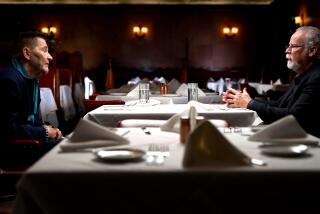Review: ‘The Poisoner’s Handbook’ on PBS: forensic medicine’s birth
- Share via
Debuting Tuesday as part of the PBS series “American Experience,” “The Poisoner’s Handbook” offers a fascinating look back at how the chemical age changed police work.
Based on Deborah Blum’s 2010 book “The Poisoner’s Handbook: Murder and the Birth of Forensic Medicine in Jazz Age New York,” it is divided into toxin-specific “chapters,” (cyanide, arsenic, carbon monoxide, lead, radium, denatured alcohol and so on), but there is nothing particularly instructional about it. A certain sort of viewer might get ideas, of course, but should he watch to the end he will learn that poisoning is a hard crime to get away with anymore.
Some credit for this goes to pioneering main characters Charles Norris, a crusading, visionary New York City medical examiner, and Alexander Gettler, who ran his toxicology labs. They were an unlikely pair, Norris from Philadelphia money but with a healthy sense of noblesse oblige (he paid for equipment and subsidized salaries in his department when money was short); Gettler, a Lower East Side Jew who liked bowling and playing the ponies. But both were dedicated to “a medical-legal justice system” and the rule of science.
WINTER TV PREVIEW: Full coverage of the season’s shows
The film, which seems to be about one thing and then another, is also a story of New York itself during Prohibition and the Depression, a melting pot on a high flame. It’s as well about the birth of American forensic science and the transformation of the untrustworthy office of the coroner — formerly a political appointment, with no qualifications needed and plenty of opportunity for graft — into the much-respected forensic science of current practice and pop culture. And it’s a chronicle of the chemicals and compounds that transformed modern life even as they made it deadly in brand-new ways.
And finally, it’s a story of human fecklessness and haplessness — of the injuries we do, not just through spite or greed but from our love of convenience: Call it suicide by technology. Norris and Gettler set themselves not only against murderers and policemen — their evidence often being exculpatory — but against the makers of radioactive watch dials and of lead-laced gasoline. (The lesson being that as hard as it might have been to fight City Hall, going up against Standard Oil and General Motors is simply impossible.)
For not all of the deaths investigated in the course of “The Poisoner’s Handbook” are murders — even some that first seem to be. Carbon monoxide, present in the gas used for lighting, cooking and refrigeration, killed more New Yorkers in a year than measles, tuberculosis and typhoid combined. And both Norris and Gettler were opposed to Prohibition, seeing correctly that it would not end the consumption of alcohol but only promote the consumption of bad, sometimes deadly, alcohol. (“Our national experiment ... in extermination,” Norris called it.)
BEST TV OF 2013 Lloyd | McNamara
There are many re-created events in courtrooms, at crime scenes and in the lab, with its many attractive antique instruments, that go on a little longer than is usual in such films. They have a goofy charm that fits the film’s bemused tone.
Norris to cop: “You can’t hold that man for murder. He didn’t kill her. ... I’m taking possession of the body.”
Cop: “The D.A.’s not going to like this.”
Gettler to staff: “Instead of breaking down the tissue with acid we’ll dry it out in a steam bath and then ash it in the electric muffle.” That’s a real thing; I looked it up.
-------------------------
‘American Experience: The Poisoner’s Handbook’
Where: KOCE
When: 8 p.m. Tuesday
Rating: TV-14 (may be unsuitable for children under the age of 14)
More to Read
The complete guide to home viewing
Get Screen Gab for everything about the TV shows and streaming movies everyone’s talking about.
You may occasionally receive promotional content from the Los Angeles Times.







